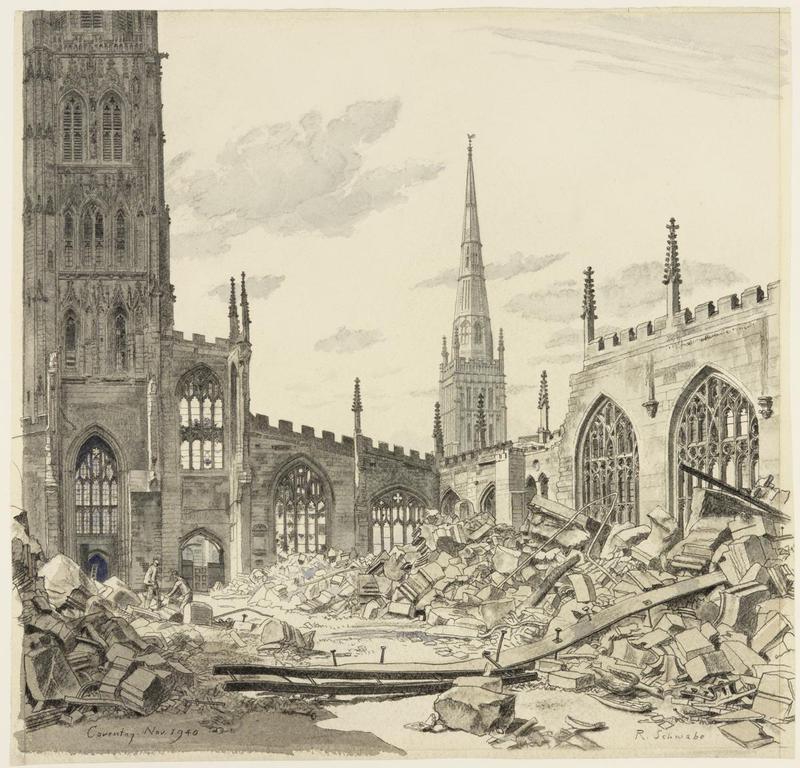The War Requiem is one of the most important 20th-century oratorios. It was composed to celebrate the consecration of the new Cathedral Church of St. Michael in Coventry built after the former was destroyed. In addition to the Latin text of Missa pro defunctis (Mass for the Dead), the work is set to nine poems by Wilfred Owen, a poet who wrote and died during the First World War. Thus, the two great tragedies of the 20th century were merged into one.
The oratorio conveys Benjamin Britten’s (1913–76) pacifist views. Called the ‘British Orpheus,’ this most renowned British composer (perhaps not only of the 20th century), pacifist and individualist (which might have been due, in part, to his homosexuality), wrote the work to mark the consecration of St. Michael’s Cathedral in Coventry built after the old one was destroyed during the Second World War.
Britten combined the Latin text of the Missa pro defunctis (Mass for the Dead) with nine poems by Wilfred Owen written during the First World War. In doing so, he referred to the two great tragedies of the 20th century. The immediate impulse for the oratorio was provided by the Second World War which Britten experienced himself (partly in the United States where he went in the face of rising tensions in 1939): the former 14th-century cathedral in Coventry was levelled during a bombing raid on the city in November 1940. His childhood was spent in the shadow of the First World War which also had a direct bearing on the life and writings of Wilfred Owen (1893–1918) whose poetry reflects the tragedy and dread of wartime experiences. Owen died on the front in France on 4 November 1918, just a few days before the Armistice, at the age of 25.
The composer scored the War Requiem for three solo voices (soprano, tenor and baritone), mixed choir, boys’ choir (a necessary element given England’s strong tradition in this area), organ and two orchestras: a full orchestra and a chamber orchestra. Interestingly, he intended the solo roles for three performers coming from the countries that fought in the Second World War: Galina Vishnevskaya from the USSR (soprano), Peter Pears from the UK (tenor) and Dietrich Fischer-Dieskau from Germany (baritone). However, the Soviet authorities did not permit Vishnevskaya to take part in the première (although she was later allowed to record the piece in London) and the soprano role had to be prepared by the Irish singer Heather Harper on ten day’s notice.
It is worth adding that Britten and Pears (one of the most eminent tenors of the second half of the 20th century) had a long-standing personal and artistic relationship that started in 1937. Pears was the first performer of the leading roles in all major Britten’s operas and it was also for him that the latter composed most of his song cycles, like Seven Sonnets of Michelangelo (1940) or Holy Sonnets of John Donne (1945).
The War Requiem was dedicated to the composer’s friends who were soldiers. Britten and Pears’ private list included David Gill, Roger Burney, Michael Halliday and Piers Dunkerley. The first three died in combat. Dunkerley, one of the composer’s closest friends, took part in the 1944 Normandy landings. He survived, but the war trauma affected his mental health so much that he committed suicide in June 1959, two months before his wedding. This is undoubtedly why Britten decided to select poems by Owen to provide a moving, at times controversial, commentary to the liturgical text.
The duration of the War Requiem is approximately an hour and a half. The monumental composition requires a spatial arrangement of ensembles divided in the following way: the chamber orchestra accompanies intimate poetic phrases (sung by the tenor or baritone), whilst the soprano, choirs and the full orchestra are used for the Latin mass sections. The mood of the entire work is set by the tritone C-F sharp as the main structural element around which further harmonic and melodic relationships are centred. Its scathing and harsh sound is symbolic: in the musical literature, the tritone is referred to as diabolus in musica (literally ‘devil in the music’), a term coined by the German theoretician Johann Joseph Fux in his 1725 treatise. Although it is not true that the interval was banned in old church music, Britten’s decision is telling.
Two fragments deserve special attention. The quiet part opening the piece (Requiem aeternam) is broken with the introduction of the first poem by Owen: Anthem for Doomed Youth, sung by the tenor. The same motif comes back in the finale, cutting into the double bass march (Libera me, Domine). Another key element, and probably the most beautiful part of the War Requiem, is the Offertorium that combines the liturgical and poetic narratives. The choral fugue about the promise made by the biblical Abraham clashes with the very dramatic poem by Owen The Parable of the Old Man and the Young (tenor and baritone duo) that compares the sacrifice of Isaac to the deaths of young, innocent soldiers in the First World War. Furthermore, when the boys’ choir suddenly starts singing ‘Hostias et preces tibi, Domine’ (‘Lord, in praise we offer you sacrifices and prayers’), the listener is taken back to Britten’s canticle Abraham and Isaac of 1952.
The Requiem has yet another important context: in 1940, the Japanese government commissioned Sinfonia da Requiem to commemorate the 2600th anniversary of the founding of the Empire. The Japanese did not like the symphony and they rejected the score due to its foreign Christian elements. As a result, the composer dedicated the work to his dead parents. As we can see, the saying that music is a universal language with a power to soothe a savage breast is not always true.
For more information about origin and content of the War Requiem, please visit the following website which offers many videos, photographs and texts: https://brittenpears.org/explore/benjamin-britten/music/war-requiem/



